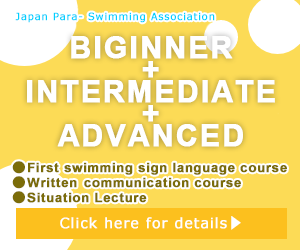Japan Para- Swimming Association
You can do it now! Swimming Sign Language Online Course
Sign language is difficult, isn’t it?
No, sir! Actually, it’s not!
I want to spread the joy of swimming to more people!
Interested in sign language but don’t know where to start?
I want to know what sign language I can use at the sports club and how to deal with hearing impaired people.
I want to concentrate on words and phrases specific to teaching swimming
If any of these apply to you, this is the place for you!
111 phrases with swimming-specific
vocabulary and expressions
You can learn it all at once!
*In the Advanced Course Situation Videos, you will practice 111 phrases while watching situations that build on what you have learned in the Beginner and Intermediate Courses.
Check out the video sample first!
Testimonials from swimming instructors using “sign language” in swimming lessons around the country

I give swimming lessons to children with intellectual disabilities who have difficulty communicating with me, using simple sign language (though only gestures). This is used as a cue, and the child can easily understand it, so there are fewer misunderstandings.

If you have a developmental disability and have little speech and strong visual information, you can get the message across better with “sign language” and “written communication” that you can see with your eyes, and they enjoy practicing with you.

Many members of the class who attend the lessons are able to communicate with those who are far away (able-bodied people) by gestures. I can also learn sign language, and I can talk with people with hearing loss using sign language and written communication, so I can kill three birds with one stone. It’s a good thing to remember.

Even if the pool mask fogged up and the mouth shape was not visible, as long as the instructor made only mouth shapes and sign language without speaking, the lesson content could be conveyed to the hearing impaired people, so it was safe!
Actual feedback from a participant in a swimming class with sign language

Few swim instructors can use sign language. I would rather swim as much as possible than spend more time communicating and less time swimming, so it’s helpful to be able to discuss things in sign language or written communication.

Hearing impaired swimmers can swim with us in our regular group classes as long as they do not have disabilities in other parts of their body. At that time, we can tell you our usual practice with sign language, so once you learn it, you can use it as a phrase a lot later, and sometimes the sign language comes before the mouth.
How was it?
Learning “sign language” is a very useful skill for swim instructors with disabilities, not only for those who are hearing impaired, but also for those who have difficulty expressing themselves verbally with other developmental and intellectual disabilities.
We hope that this program will spread to many sports clubs and people involved in swimming instruction, and we hope to reduce the number of people who are unable to enjoy swimming due to language barriers and increase the number of warm swimming classes.
In fact, because of the Corona Disaster, learning “sign language” will make the lessons easier to understand not only for the hearing impaired but also for the people around you, and will create an atmosphere where you can feel the warmth of the people in the class, such as making more friends.
Do you have an image of a “sign language interpreter” like on TV?
But isn’t ‘sign language’ actually difficult?”
I want to use sign language, but what if there is a misunderstanding?
“What should I ask someone when I don’t understand what they’re saying?”
If you are thinking, “I’m not sure what to do…”, don’t worry.
A sign language interpreter is a professional sign language interpreter who is required in public places.
To put it simply, a sign language interpreter is a professional who is required to be able to speak in a way that anyone can understand, just like an announcer.
It is often misunderstood that you do not need to become a “sign language interpreter” to be able to communicate in daily life.
It is the same as we can have a conversation without becoming an announcer.
Sign language is “Kotoba”, the same as Japanese and English.
There are some detailed grammar rules, but unlike English, which is far away from Japanese, sign language is the closest language to Japanese.
Starting with the beginner’s level “greetings”, we will practice the vocabulary and expressions necessary for teaching swimming. We will also teach you how to express yourself in a way that is unique to sign language in the course, so please don’t worry.
Have you ever heard of written communication?
Sign language” is not the only way for people with hearing impairment to communicate.
It is a way to communicate by writing on paper.
Writing” also requires expertise and skill, but there is a difference between writing skills at a lecture and writing skills in everyday life.
You are not required to have “lecture-level” written communication skills that can be understood by all 100 people in a room of 100.
What is required is the skill to “communicate to one person in front of you with certainty and politeness”.
There is no need for special skills such as typing speed or shorthand.
It is enough if you can write with a pen.
It is enough if you can write with a pen, and if you can keep in mind the points that you should pay attention to at the sports field or at the reception desk of a sports club.
This time, as a commemorative campaign for the opening of the course, we are offering the course at a more affordable price than usual for a limited period of time.
Check out the video sample first!
There aren’t any sign language classes dedicated to sports clubs or swimming lessons!
I myself had the same problem as you.
I only knew a little “sign language”, but being able to have a daily conversation and being able to use sign language in swimming lessons are completely different words. I myself had the same problem as you.
I had the same problem as you. I only knew a little sign language, but being able to have an everyday conversation and being able to use sign language in the swimming class are completely different words.
For example, the four swimming techniques commonly used in swimming instruction, such as crawl, backstroke, butterfly, and breaststroke, are not taught because they are not part of everyday conversation.
They become a frame of jargon. For example, the four swimming techniques often used in swimming instruction, such as crawl, backstroke, butterfly, and breaststroke, are not taught because they are not part of everyday conversation.
They become a frame of jargon.
Also, just like in English, you may not be able to remember words you don’t use everyday, or you may not have learned them in the first place and don’t know what to do. And just like in English, if you don’t use a word you don’t know, you can’t remember it or you don’t know it because you haven’t learned it in the first place.
Furthermore, running a business limits the amount of time you have to study sign language.
It is hard to find 15 minutes a day to study sign language.
It is under these circumstances that I have been studying sign language. Furthermore, when you are running a business, you have limited time to study sign language because of the lack of time.
It is very hard to find 15 minutes a day to study sign language.
Under such circumstances, I have been studying sign language.
I have been very happy to share the signs I have learned with my fellow swim instructors. I have been very happy to share the signs I have learned with my fellow swim instructors.
Because of this, I have been troubled by my own problems, which is why I thought that both busy swimming teachers and sports club receptionists need an environment where they can learn everything from the language used in swimming instruction to contract-related matters specifically. I have been struggling with this myself, which is why I think that busy swimming teachers and sports club receptionists need an environment where they can learn everything from the language used in swimming instruction to contractual matters in a specialized way.
That’s how we created this “Swimming Sign Language” course.
Check out the video sample first!
This “Swimming Sign Language” course is divided into three steps.
For those who are new to sign language
Start with greetings and basic signs
If you’re new to sign language, start here!
What is hearing impairment? What is sign language? …You will master the basics of sign language in about a month.
<Curriculum>Excerpts
What is hearing impairment, fingers, numbers, days of the week, greetings, self-introductions, what to wear, etc.
Written communication course
We will teach you the key points for easy-to-understand written communication in the field of swimming instruction.
Even if you don’t understand sign language, you don’t have to be afraid if you can communicate in writing!
You will master the written communication skills necessary for swimming in about 3 days.
<Curriculum>Excerpts
What is written communication? Let’s get familiar with written communication! The key points of written communication, Let’s try written communication! etc.
Situation Lecture
Assuming that there is a customer with hearing impairment in front of you, you will practice a scene in which you are taking a swimming lesson and a scene in which you are communicating with a customer at the reception of a sports club, such as signing a contract.
<Excerpts from the curriculum
Swimming lesson” situation, “Sports club receptionist” situation
We use “teachable”, an e-learning site that is widely used around the world, in order to make our online course system easy to use and easy to work with.
Payment of course fees can be made by credit card or bank transfer without worrying about security, and the entire course can be completed at once.
After registering on the Swimming Sign Language Course website (register your email address), log in to the course and proceed through the curriculum (courses).
The number of courses varies depending on the course, but each video is about 5 to 10 minutes long, making it easy for busy people to take the course and for first-time students to understand.
All of these courses have options.
You can ask questions if you don’t understand!
You can ask questions during the course by e-mail.
(limited to the content of the course, up to 2 emails back and forth)
We will correct your videos.
I want to use what I learned in the Swimming Sign Language course in the field! But I don’t have anyone to watch me…
This option is recommended for those who want to see if they are fluent in sign language.
Flow of video correction
①Take a 1-minute video of yourself using a smartphone or other device.
②Send the video by e-mail
③You will receive an email from the association with the results of the correction later! (About 2 weeks, video reply)
For companies and organizations only, we can also provide training tailored to the actual conditions of your club. Please contact us individually.
Together, we can make the swimming world a better place!
We would be more than happy to share the joy of swimming with as many people as possible. Let’s make the swimming world a better place together!
I would be more than happy to share the joy of swimming with as many people as possible.
Harmful swimming coach Yasuha Sakai





